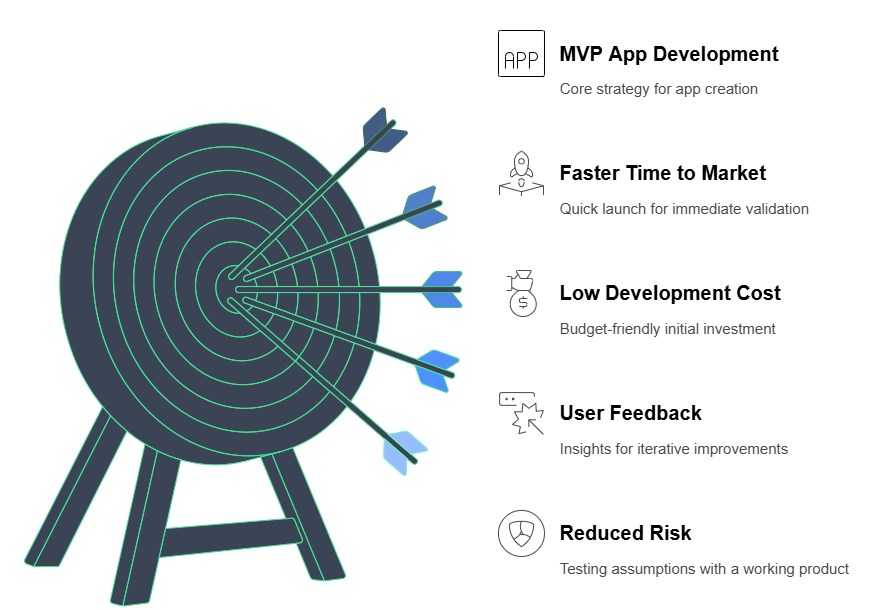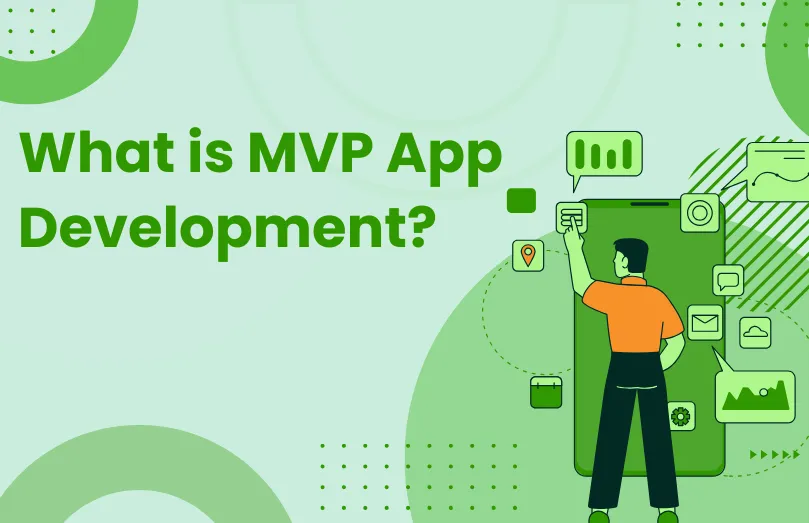Ever had a fantastic app idea? You have perhaps developed and conceived that exciting app with all well-integrated features and functionalities. That ultimate vision is important, but often all successful apps are conceived from something leaner and more focused: an MVP.
So, what is MVP app development? Minimum Viable Product app development is an intelligent strategy for startups and established businesses alike.
MVP app development means launching the rudimentary version of the app, having the main features to solve a core problem in the target audience, and, at the same time, gathering some good feedback.
You are then able to get a product into their hands quickly, rather than spending many months (or even years) developing what might turn out to be a fancy app, only to find out it doesn’t resonate with users.
It helps you test your assumptions, learn what users really need, and iterate based on actual usage. This is particularly valuable in on-demand app development, where speed and user feedback matter most.
Breaking Down MVP App Development
The MVP App Development involves building a bare minimum viable version of the app, without which no value is derived for the early adopters. It’s not about building a half-baked product but figuring out what centric functions will address the major pain that your app will address.
Minimum again refers to the least amount necessary for the app to do when it comes to use and value. Viable refers to the level of functioning that allows users to use it and provide meaningful feedback.
Why Choose MVP App Development?

The MVP app development route is a practical option for several key reasons:
- Faster Time to Market: Since this model only focuses on essential features, the app can be launched much faster than if an extensive project were developed. This guarantees that validation starts immediately, thus providing early user feedback.
- Low Development Cost: By initiating some features to keep the MVP running, lower initial development costs are assured. This is particularly beneficial for startups with limited budgets.
- User Feedback in Advance: Getting the app into the marketplace with real users is the best thing that you can do at this stage. Their feedback will inform you about the next step in the development cycle, thus providing you with an opportunity to build your next version to their specifications and needs.
- Reduced Risk: By testing your core assumptions with a working product, the risk of expending the time and money necessary for building such features is significantly reduced, while actually minimizing the risk that these extras would be unwanted or unneeded by users.
- Iterative Development: MVP app development handles things in an iterative flow. Launch the basics, and then take feedback and keep improving while adding features based on what was learned.
- It will also allow you to attract the early adopters who tend to be more forgiving of initial shortcomings and are happy to give feedback.
- Now, a working MVP with some traction among users can draw investors’ interest more than an idea or a long-winded development plan.
A fundamental first step for businesses looking to capitalize on the mobile app space efficiently is to gain an understanding of what MVP app development is.
Key Steps in MVP App Development
The MVP app development process normally consists of these key steps:
- Identifying the Core Problem: Define what the application seeks to solve for the target audience.
- Identify Core Features: Identify the absolute minimum number of features needed for a workable and worthy solution based on the core problem.
- Feature Prioritization: Using a prioritization framework (such as MoSCoW: Must have, Should have, Could have, Won’t have), prioritize the features necessary for your MVP.
- Build the MVP: Develop these important core features with an attention-grabbing design and a working user experience. Remember, “minimum” does not equate to “quality.”
- Launch and Gather Feedback: Take your MVP out with a select group of target users, or take it broad for a huge audience, and start collecting feedback on what works, what doesn’t, and what they would like next.
- Analyze and Iterate: Analyze the feedback you’ve received and use it in the next iterations of your development. Prioritize features around user needs and business goals.
Choosing the right MVP app development company is extremely important for the success of this process; they should know all the principles of lean development and should be able to build a functional product while also maintaining efficiency.
MVP App for Business: Real-World Examples
Many successful apps started as MVPs. Here are a few well-known examples that illustrate the power of the MVP approach:
- Airbnb: Airbnb started as a simple website that allows people to rent air mattresses in their homes. The core problem was finding affordable accommodation.
- Uber: Began as a service connecting a small group of users with a few drivers via SMS. The core problem was convenient transportation.
- Spotify: Launched with a focus on providing access to a limited library of music for streaming. The core problem was accessing music easily.
These examples highlight how focusing on a core value proposition and gathering early user feedback can lead to massive success over time.
The initial versions were far from the feature-rich apps we know today, demonstrating the effectiveness of the MVP app for business strategy.

Choosing the Right MVP App Development Company
Selecting the right partner for your MVP app development is a critical decision. Look for a company that:
- Understands the MVP philosophy: They should prioritize building a lean and functional product quickly.
- If you have experience building successful MVPs, make sure you ask for case studies and testimonials.
- They are willing to communicate openly: You want to be a part of the development process.
- Offers advice on what features to prioritize for an MVP: They should help identify the key features that your MVP must have.
- Offers support and iterations once the app goes live: The MVP is just the beginning; you need a partner who will continue to develop it.
Conclusion
It is one good strategy that gives wings to efficiently and effectively implement your app idea. Build an MVP by focusing solely on its core value proposition for a quick launch, and increase the chances of successful app development by iterating through continuous user feedback. Adopt the lean approach, learn from your users, and let your app blossom to its full potential.
For a streamlined development process, explore our app development services. We’re dedicated to transforming your idea into a successful app that resonates with your target audience!


